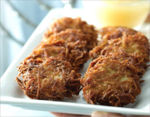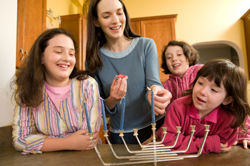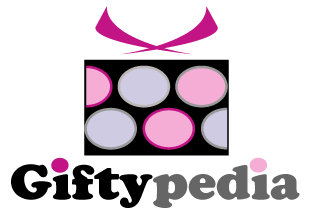History of Hanukkah
From Giftypedia
Hanukkah, also known as the “Festival of Lights” is an eight-day Jewish holiday beginning on the 25th day of the month of Kislev, which may fall anytime from late November to late December.
According to Jewish tradition, Hanukkah commemorates the dedication of the Holy Temple in Jerusalem after the Jews victory over the Syrians in 165 BCE. Before then, Antiochus, the Greek King of Syria outlawed Jewish traditions and ordered people to worship Greek Gods. In 168 BCE, the holy temple was seized and dedicated to worshiping Zeus.
Many Jews were angry at this and decided to fight back.
Fighting started in the village of Modiin, near Jerusalem. A Greek officer and his soldiers assembled the villagers, asking them to bow to an idol and eat the flesh of a pig, which are activities forbidden to Jews. The officer asked a Jewish High Priest, Mattathias, to take part in the ceremony. Mattathias refused, and another villager stepped forward and offered to do it instead. Outraged, Mattathias was took out his sword and killed him and the officer. Mattathias' five sons and the villagers then attacked and killed the soldiers. Mattathias' family went into hiding in the nearby mountains, where many other Jews who wanted to fight the Greeks joined them. They attacked the Greek soldiers whenever possible.
Judah Maccabee, one of Mattathias' sons and his soldiers went into the Temple, and were sad to see many things were missing or broken, including the golden menorah. The soldiers cleaned and repaired the Temple, and when they were finished, they decided to have a ceremony. For the celebration, the Judah wanted to light the menorah. They looked everywhere for oil, and found a small flask that contained only enough oil to light the menorah for one day. Miraculously, the oil lasted for eight days. This gave them enough time to obtain new oil to keep the menorah lit. Today Jews celebrate Hanukkah for eight days by lighting candles in a menorah every night, as a way to commemorate the eight-day miracle.
Hanukkah Traditions
   
|
- Menorah - The seven-pronged candelabrum is burned for eight days to commemorate the eight-day miracle of the burning oil.
- Fried Food - Fried foods are eaten at this time because it reminds Jews of the miracle of the oil burning for eight days. Potato pancakes are often eaten during this time of the year.
- Dairy- Dairy is often eaten this time of the year to commemorate the story of Yehudit. Yehudit was a woman who saved her village from the Syrians, who were holding the villagers under siege by starving the Jews so they would surrender. She went to the governor of the Syrians troops and brought him cheese and wine. When the governor got drunk and collapsed on the floor, Yehudit took his sword and beheaded him. She brought his head back to her town in a basket. The next morning the Jews began attacking the Syrian troops. When the Syrians ran to the governor and found him on the ground beheaded, they got scared and fled. In memory of this story, it has become a tradition to eat dairy food on Hanukkah.
- Dreidel – Playing the dreidel[1] is a tradition that came about during the oppression of Antiochus. The study of the Torah was forbidden so the Jews used the tops to cover their illegal activity by playing a gambling game with the tops. The markings on the driedel are the Hebrew letters Nun, Gimel, Hei and Shin. The letters stand for the phrase "Nes Gadol Hayah Sham", a great miracle happened there, referring to the miracle of the oil. The markings also stand for the Yiddish words nit (nothing), gantz (all), halb (half) and shtell (put), which are the rules for the gambling game.
| How to Play the Dreidel Game |
|---|
What is Needed to Play
Playing the Game
|
Jewish Holidays
- History of Rosh Hashanah
- History of Ten Days of Repentance
- History of Yom Kippur
- History of Sukkot
- History of Hanukkah
- History of Purim
- History of Passover
- History of Shavu'ot
- History of Shemini Atzeret
Notes


 Printer Friendly
Printer Friendly
